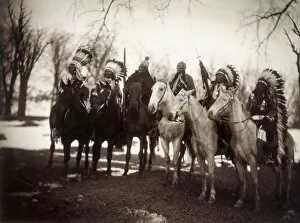American Horse Collection
Amidst the vast plains of the American West, the spirit of the Sioux Nation thrived
All Professionally Made to Order for Quick Shipping
Amidst the vast plains of the American West, the spirit of the Sioux Nation thrived. From the Piegan's Little Plume to the Chiricahua Apache's Geronimo, six tribal chiefs (L to R: Little Plume, Buckskin Charley, Geronimo, Quanah Parker, Hollow Horn Bear, and American Horse) stood strong against the tides of change. Their ceremonial attire, a testament to their rich heritage, was captured by Edward S. Curtis around 1900. As the world outside their lands evolved, so too did the dynamics of the Sioux people. In 1891, Lakota Sioux chiefs and white U.S. Officials, including Buffalo Bill Cody, gathered at the Pine Ridge Reservation in South Dakota. This meeting, symbolizing the complex relationship between the two groups, was documented by John C.H. Grabill. The U.S. Allotment system, introduced in 1907, brought about significant changes. A surveyor and his interpreter are seen measuring land, marking the beginning of a new era for the Sioux people. Among the Sioux Nation, the stories of individuals like Mrs. American Horse, an Oglala Sioux woman, and her son, Charles American Horse, continue to resonate. Their portraits, captured by various photographers around 1900, offer a glimpse into their lives and the enduring spirit of the Sioux Nation.










